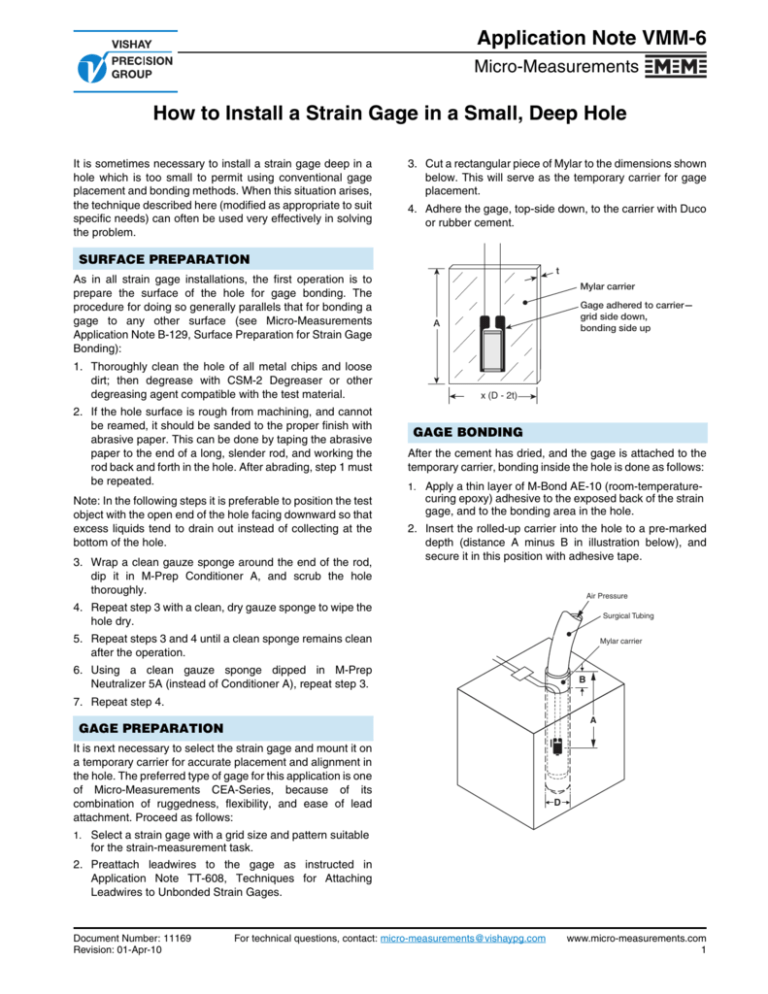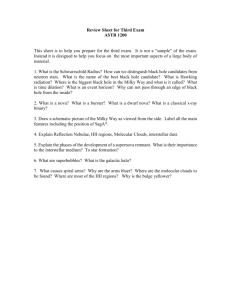How to Install a Strain Gage in a Small, Deep Hole
advertisement

Application Note VMM-6 Micro-Measurements How to Install a Strain Gage in a Small, Deep Hole It is sometimes necessary to install a strain gage deep in a hole which is too small to permit using conventional gage placement and bonding methods. When this situation arises, the technique described here (modified as appropriate to suit specific needs) can often be used very effectively in solving the problem. 3. Cut a rectangular piece of Mylar to the dimensions shown below. This will serve as the temporary carrier for gage placement. 4. Adhere the gage, top-side down, to the carrier with Duco or rubber cement. SURFACE PREPARATION As in all strain gage installations, the first operation is to prepare the surface of the hole for gage bonding. The procedure for doing so generally parallels that for bonding a gage to any other surface (see Micro-Measurements Application Note B-129, Surface Preparation for Strain Gage Bonding): 1. Thoroughly clean the hole of all metal chips and loose dirt; then degrease with CSM-2 Degreaser or other degreasing agent compatible with the test material. 2. If the hole surface is rough from machining, and cannot be reamed, it should be sanded to the proper finish with abrasive paper. This can be done by taping the abrasive paper to the end of a long, slender rod, and working the rod back and forth in the hole. After abrading, step 1 must be repeated. Note: In the following steps it is preferable to position the test object with the open end of the hole facing downward so that excess liquids tend to drain out instead of collecting at the bottom of the hole. 3. Wrap a clean gauze sponge around the end of the rod, dip it in M-Prep Conditioner A, and scrub the hole thoroughly. t Mylar carrier Gage adhered to carrier— grid side down, bonding side up A x (D - 2t) GAGE BONDING After the cement has dried, and the gage is attached to the temporary carrier, bonding inside the hole is done as follows: 1. Apply a thin layer of M-Bond AE-10 (room-temperature- curing epoxy) adhesive to the exposed back of the strain gage, and to the bonding area in the hole. 2. Insert the rolled-up carrier into the hole to a pre-marked depth (distance A minus B in illustration below), and secure it in this position with adhesive tape. Air Pressure 4. Repeat step 3 with a clean, dry gauze sponge to wipe the hole dry. Surgical Tubing 5. Repeat steps 3 and 4 until a clean sponge remains clean after the operation. Mylar carrier 6. Using a clean gauze sponge dipped in M-Prep Neutralizer 5A (instead of Conditioner A), repeat step 3. B 7. Repeat step 4. A GAGE PREPARATION It is next necessary to select the strain gage and mount it on a temporary carrier for accurate placement and alignment in the hole. The preferred type of gage for this application is one of Micro-Measurements CEA-Series, because of its combination of ruggedness, flexibility, and ease of lead attachment. Proceed as follows: D 1. Select a strain gage with a grid size and pattern suitable for the strain-measurement task. 2. Preattach leadwires to the gage as instructed in Application Note TT-608, Techniques for Attaching Leadwires to Unbonded Strain Gages. Document Number: 11169 Revision: 01-Apr-10 For technical questions, contact: micro-measurements@vishaypg.com www.micro-measurements.com 1 Application Note VMM-6 Micro-Measurements How to Install a Strain Gage in a Small, Deep Hole 3. Carefully route the leadwires along the inserted sheet, and tape them to the test piece surface where they come out of the hole. 4. Insert a length of surgical tubing (sealed at the end) into the hole until it is beyond the gaging area by at least 2 hole diameters. The outside diameter of the tubing should be about 0.040 in (1mm) smaller than the hole. 5. Apply air pressure to the tube at about 10psi (70kPa), and maintain the pressure for at least 6 hours, and preferably 24 hours. 6. Remove the air pressure and then remove the surgical tubing. 7. Slowly and gently peel the carrier away from the gage. Alternatively, trim off the protruding portion of the carrier flush with the hole edge, and leave the remainder in the hole. www.micro-measurements.com 2 For technical questions, contact: micro-measurements@vishaypg.com Document Number: 11169 Revision: 01-Apr-10






